Ending prison gerrymandering is one of the report's 5 main recommendations to improve democracy in the Midwest.
by Leah Sakala,
May 14, 2013
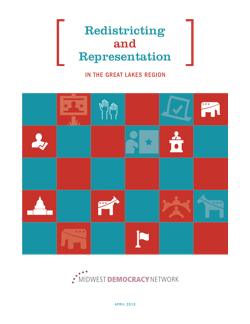
This month the Midwest Democracy Network released a great new report, Redistricting and Representation in the Midwest, providing an overview of major democracy issues in Midwestern states and offering succinct recommendations on how to improve voting fairness.
The report calls for an end to prison gerrymandering as one of the five main recommendations (page 30):
The current practice of counting prisoners as residents in the district where the prison is located artificially inflates the representation of those districts and deflates representation in other districts.
The ultimate remedy is for the Census Bureau to count people where they are from rather than where they are incarcerated. Advocacy for this policy change prior to the 2020 count is underway.
In the meantime, the best option is for correction officials to track the home addresses of inmates and provide that information for use during redistricting in 2021. Delaware, Maryland, New York, and California have adopted legislation requiring use of home addresses of prisoners during state and local redistricting. The changes were in effect in the most recent round of redistricting in Maryland and New York, and will be applied after the 2020 Census in California and Delaware.
A possible compromise option is to exclude prison populations when drawing new district lines. The Census Bureau provides information needed for this step, and more than 150 local governments around the country, including Terre Haute, Indiana, address prison gerrymandering in this way. State laws that inhibit this local approach should be changed. Michigan, for example, adopted a state law that excludes prison populations in local government redistricting.
Our partners at the Midwest Democracy Network have been great leaders in the fight to end prison gerrymandering in the Midwest, including organizing a panel all about it at their most recent conference earlier this year. To stay in the loop about their important work, check out their website or Facebook, or follow them on Twitter.
Tom Condon wrote a wonderful column for today’s Hartford Courant on why it’s time for the Connecticut legislature to pass a bill ending prison gerrymandering.
by Leah Sakala,
May 9, 2013
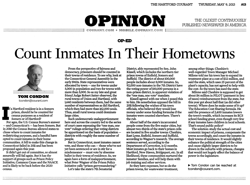
Tom Condon wrote a wonderful column for today’s Hartford Courant on why it’s time for the Connecticut legislature to pass a bill ending prison gerrymandering. Here’s an excerpt (although the full piece is absolutely worth a read):
From the perspective of fairness and democracy, prisoners should be counted in their towns of residence. To see why, look at the Connecticut General Assembly in the early 1960s. State representatives were allocated by town — one for towns under 5,000 in population and two for towns with more than 5,000. So as my late and great friend Judge Robert Satter observed, the rural towns of Union and Hartland, with 1,440 residents between them, had the same number of representatives as did Hartford, which then had more than 162,000 souls. Thus, small rural towns could dominate large cities.
Such undemocratic malapportionment here and across the country led to the series of court cases espousing the “one man, one vote” rulings ordering that voting districts be apportioned on the basis of population — districts with roughly the same number of people.
But in Connecticut, most inmates cannot vote, and those who can — those who’ve not yet been sentenced or are in stir for a misdemeanor — must vote by absentee ballot in their towns of residence. So, we again have a form of malapportionment, what Peter Wagner of the Prison Policy Initiative calls “prison gerrymandering.”
Almost half of the state's prison population comes from the state's five largest cities, but almost two-thirds of the state’s prison cells are located in just five small towns.
April 17, 2013
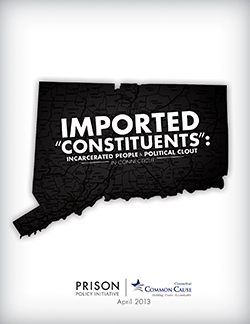
Contact:
Prison Policy Initiative – Leah Sakala (413) 527-0845Common Cause in Connecticut – Cheri Quickmire (860) 539-6846
If you don’t live next to a large prison, the General Assembly doesn’t think your vote is worth as much, charges a new report released this morning by the Prison Policy Initiative and Common Cause in Connecticut.
The report, “Imported ‘Constituents’: Incarcerated People and Political Clout in Connecticut,” examines how the state’s reliance on Census Bureau data – which counts incarcerated people as if they were residents of prison locations rather than their home communities — enhances the weight of votes cast in districts that contain prisons and dilutes the weight of a vote cast in all other districts. “About 10% of several Connecticut districts are made up of people who aren’t, by state law, residents of those districts,” said report author Peter Wagner.
The report finds that:
- Almost half of the state’s prison population comes from the state’s five largest cities, but almost two-thirds of the state’s prison cells are located in just five small towns.
- There are seven majority-White state house districts that claim at least 1,000 incarcerated people of color as residents of their districts.
- Connecticut state law says that incarcerated people are residents of their homes, not the prison location.
- Not all people in Connecticut prisons are barred from voting. Those who can vote – because they are awaiting trial or are not convicted of felonies — are required by state law to vote absentee as residents of their home districts.
The Connecticut Legislature is currently considering a bill, HB 6679, that would remedy the problem of prison gerrymandering by counting incarcerated people at their home addresses for redistricting purposes. “Right now, the Judiciary Committee has before them a bill that would end prison gerrymandering in Connecticut once and for all,” said Cheri Quickmire of Common Cause in Connecticut. “It’s time to pass this legislation and send the message that every Connecticut resident’s vote should count, regardless of whether or not he or she lives near a big prison.”
Four other states — New York, Maryland, Delaware, and California — have already passed similar legislation, and Maryland’s law was upheld by the U.S. Supreme Court last year.
The non-profit Massachusetts-based Prison Policy Initiative is the nation’s leading authority on how Census counts of prison populations distort the legislative redistricting process. For the last decade the organization has been leading a national movement calling on the Census Bureau to count incarcerated people at home, and the organization’s research inspired four states to pass legislation in 2010 and 2011 to end prison gerrymandering.
Common Cause in Connecticut is a nonprofit, nonpartisan citizens lobby dedicated to improving the way state government operates. Whether it is advocating for opening committee meetings to the public or compelling the passage of the strongest campaign finance law in the nation, Common Cause in Connecticut has been a leading voice in reforming state government.
“Imported ‘Constituents’: Incarcerated People and Political Clout in Connecticut,” is available at http://www.prisonersofthecensus.org/ct/
-30-
Vigo County will vote to approve a redistricting plan that excludes the incarcerated population at the Terre Haute Federal Correctional Complex.
by Aleks Kajstura,
April 10, 2013
Vigo County Indiana is following the lead of its county seat by ending prison gerrymandering. The Tribune Star reports that the Commissioners of Vigo County will approve a redistricting plan that excludes the incarcerated population at the Terre Haute Federal Correctional Complex.
Redistricting is generally required every decade to ensure that the residents are equally divided among the County Council districts, but Vigo County failed to redistrict for two decades. By the 2010 Census the districts had significant population differences. The County was finally pushed to taking action in response to a suit filed by a local resident with the help of the ACLU of Indiana.
In taking this opportunity to redistrict, the County also addressed its prison gerrymandering problem. The incarcerated population counted at the federal prison complex would have made up 13% of District 4 if it had been included in the redistricting data, undermining the County’s attempt to draw fair districts with equal populations.
County Attorney Michael Wright explained the County’s solution:
“Once we declare that we are not considering the federal penitentiary’s population for purposes of calculation, the proposed plan would bring the precincts with one and a third percent of each other in terms of population.”
When the districts are finalized by an upcoming Council vote, Vigo County will join the Indiana cities of Terre Haute and Crown Point as well as over 200 other local governments nationwide in ensuring equal representation by avoiding prison gerrymandering.
The Connecticut Joint Committee on Judiciary heard testimony in support of legislation to count incarcerated people at home for redistricting purposes.
by Leah Sakala,
April 2, 2013
Will Connecticut be the next state to bring an end to prison gerrymandering?
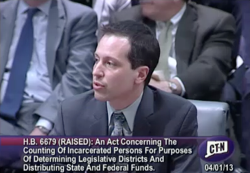
Yesterday Peter testified before the Connecticut Legislature’s Joint Committee on Judiciary in support of HB 6679, a bill that would end prison gerrymandering by requiring incarcerated people to be counted at their home addresses for redistricting purposes (you can watch Peter’s testimony at CT-N starting at 5 hours 38 minutes).
Leah Aden of the NAACP LDF submitted testimony in support of the bill, and David McGuire of the ACLU of Connecticut testified in support as well.
Our allies at Common Cause in Connecticut have been instrumental in getting this issue on the legislature’s agenda, and there’s a broad base of support from the public and the press for ending prison gerrymandering in Connecticut. Editorial boards such as the Hartford Courant and the Norwich Bulletin have called on the legislature to pass legislation like that in New York, Maryland, Delaware, and California to ensure that the Census Bureau’s method of tabulating prison populations doesn’t skew democracy in Connecticut.
We joined our colleagues in partner organizations to urge the Massachusetts Legislature to take a stand for electoral fairness by urging the Census Bureau to end prison gerrymandering.
by Leah Sakala,
March 28, 2013
The message is loud and clear: Massachusetts wants to see an end to prison gerrymandering.
Yesterday afternoon Prison Policy Initiative Legal Director Aleks Kajstura and I attended a hearing before the Massachusetts Legislature’s Joint Committee on Election Laws to testify with a great group of colleagues in support of Resolution S 309/H 3185, a resolution urging the Census Bureau to end prison gerrymandering by counting incarcerated people at their home addresses.
Representative Jim O’Day kicked off the testimony in support of the resolution, explaining why it’s important that the people who are incarcerated in his district be counted at their home addresses in the next Census. Aleks spoke and submitted joint testimony on behalf of Prison Policy Initiative and Dēmos, and she was joined by Pam Wilmot of Common Cause Massachusetts, Professor Carroy Ferguson of UMass Boston, Kevin Peterson of the New Democracy Coalition, Marinella Blake of EPOCA, Sunni Ali of the Boston Workers’ Alliance, Rahsaan Hall of the Lawyers’ Committee for Civil Rights and Economic Justice, Sara Brady from MassVOTE, and Gavi Wolfe from the ACLU of Massachusetts (testimony).
We also submitted a joint letter from 24 Massachusetts-based organizations calling on the Joint Committee of Election Laws to pass the resolution, and Leah Aden of the NAACP LDF submitted a memo of support for the resolution. As we note in the joint letter,
The Census Bureau considers state and local redistricting to be the second most important use of census data, and actively solicits feedback from states on their experiences using Census data for reapportionment. The Massachusetts Legislature’s opinion on this matter carries great weight with the Census Bureau, so we urge you to pass Resolution S 309/H 3185.
As always, we’ll keep you posted with this blog and our Massachusetts organizing page as soon as updates are available!
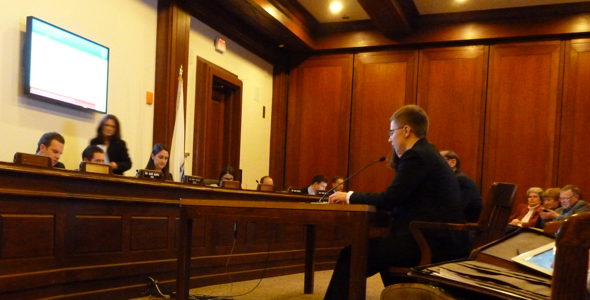
Prison Policy Initiative Legal Director Aleks Kajstura testifies in support of calling for an end to prison gerrymandering
Governor signs HB1339, changes law that required some counties to dilute the votes of county residents who did not live adjacent to a prison.
March 20, 2013
For immediate release: March 20, 2013
Contact:
Virginia New Majority: Deshundra Jefferson, (347) 834-3035
Prison Policy Initiative: Leah Sakala, (413) 527-0845
Dēmos: Lauren Strayer, 212-389-1415 or lstrayer@demos.org
Governor signs HB1339, changes law that required some counties to dilute the votes of county residents who did not live adjacent to a prison
Virginia Governor Bob McDonnell on Monday signed HB 1339, which ends a state requirement that forced some local governments to engage in prison gerrymandering. The new law lifts limitations on which counties, cities and municipalities could exclude incarcerated populations for redistricting purposes. Rural counties that host prisons find that relying on the Census Bureau’s counts to draw districts can result in a single prison being the majority of a district, even though the incarcerated population is denied the right to vote. This distorts representation by giving disproportionate influence to the residents of the prison district and diluting the votes of residents of all other districts. The problem is often called “prison gerrymandering.”
“HB1339 caps a twelve-year effort to roll back a unique provision of Virginia law that barred local governments from making adjustments to the federal Census data,” said Peter Wagner, Executive Director of Prison Policy Initiative and a national expert on prison gerrymandering.
Virginia’s law now matches that of most states.
“Most states give local governments the choice to avoid prison gerrymandering, and a few states like Colorado and Michigan actually prohibit local governments from using Census Bureau prison counts to enhance the votes of some residents to the detriment of other residents,” said Brenda Wright, Vice-President for Legal Strategies at Dēmos.
“Ideally, the Census Bureau would tabulate incarcerated people where they reside, at home, so that all districts could be drawn more fairly” said Tram Nguyen, Deputy Director of Virginia New Majority, noting that incarcerated people can’t vote in Virginia but remain legal residents of their homes while they are incarcerated.
“But Virginia has today given rural counties the option to fix an obvious flaw in the decennial Census and draw fairer districts in the future. I expect most counties will take this opportunity when they next redraw their lines,” Nguyen added.
About the Virginia law
Prior to 2001, Virginia law required local governments to redistrict based on “figures … identical to those from the actual enumeration conducted by the United States Bureau of the Census” with no flexibility provided to correct for any inequities that might cause.
In 2001, the legislature amended the law to give some counties — those whose total population was at least 12% incarcerated — the option to exclude the prison population. This change freed some counties from the impossible situation of drawing districts that were entirely incarcerated, but still required counties like Southampton to draw a district where more than half of the population is in prison. Residents of that one district received twice the influence over Southampton County affairs as residents in other districts without the prison.
Efforts to amend the law in time for the 2011 redistricting were unsuccessful, but in 2012, the legislature unanimously passed legislation to give any jurisdiction faced with drawing a district that would be 12% or more incarcerated the option to adjust the Census and remove the non-resident prison population. The newest amendment extends the choice to avoid prison gerrymandering to all counties, cities and towns that contain correctional facilities.
HB 1339, sponsored by Delegate R. Lee Ware, Jr. (R-Powhatan) passed the House unanimously on January 23, and with bipartisan support in the Senate on February 15. The bill applies only to county, city or municipal redistricting, and does not apply to funding or other uses of Census data, including state redistricting.
National context
“My research has shown that the vast majority of counties and municipalities that host prisons reject prison gerrymandering. The majority of the exceptions are in states where state law is believed to require the absurd result of prison gerrymandering. Virginia fixed the problem with their state law. States like Minnesota, Tennessee and Wisconsin should follow Virginia’s lead,” said the Prison Policy Initiative’s Peter Wagner.
“By signing HB 1339, Governor McDonnell put Virginia in firmly in the camp of states that have rejected prison gerrymandering and helped ensure an equal voice for all citizens,” explained Brenda Wright of Dēmos. “Four states have recently passed legislation that ended prison gerrymandering for state legislative redistricting. The legislation in California and Delaware applies just to state legislative districts, but Maryland and New York both passed comprehensive legislation that applied to both state and local redistricting. Virginia has taken an important first step by freeing local governments from a state requirement at odds with the constitutional principle of ‘One Person One Vote’.”
-30-
H5283/S0147 would require that incarcerated people be reallocated to their home addresses for redistricting purposes after the 2020 Census.
by Leah Sakala,
March 14, 2013
Earlier this week, Peter and I headed down to the Rhode Island State House to testify before the Rhode Island House Committee on Judiciary in support of H5283/S0147, Rep. Anastasia Williams’ bill to end prison gerrymandering.
The issue of prison gerrymandering is especially dramatic in Rhode Island because the state’s prisons are all concentrated in just one area. Currently, nearly 15% of one State House District in the Cranston area is made up of incarcerated people from other places. This means that 85 people in that district have as much say in state politics as 100 people in any other district.
The proposed bill would require that incarcerated people be reallocated to their home addresses in the data used for Rhode Island’s next reapportionment cycle (much like the bills that were passed and successfully implemented in New York and Maryland).
Our colleagues John Marion from Common Cause Rhode Island, Steven Brown from the Rhode Island ACLU, and Derry Riding of the League of Women Voters of Rhode Island testified in support of the bill as well. Members of Direct Action for Rights and Equality and Open Doors also expressed their support for the legislation.
For pictures from the hearing, check out our Facebook album!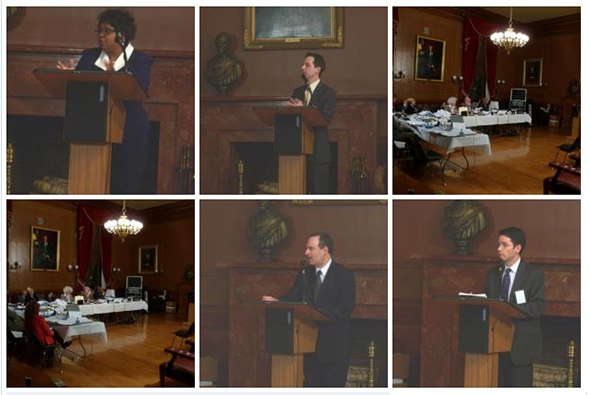
By removing the prison population for redistricting purposes, Granville can draw fair districts that contain equal numbers of actual residents.
by Leah Sakala,
March 12, 2013
A few months ago, we wrote a post about why the new county commissioner districts in Granville County, North Carolina are such a clear example of how prison gerrymandering hurts local government democracy. But now, fortunately, the county has second chance to fix the problem.
The opportunity arose when county officials realized that the 2010 Census data they relied on to draw their new districts had counted a federal prison that straddles the county line entirely within Granville County by mistake. Now that county officials have realized the Census Bureau’s error, they have decided to redraw the commissioner and school board districts with population data that does not include the portion of the prison population that is outside Granville County. But there’s an even simpler solution that leads to a fairer result: they can end prison gerrymandering by simply removing the prison population altogether from the data used to draw the revised districts.
Under the county’s current plan, some Granville County residents get twice as much political influence as others simply because they live near the prison. By removing the prison population for redistricting purposes, Granville can draw fair districts that contain equal numbers of actual residents. Granville should take this opportunity to join the more than 200 other local governments across the country that have decided to prevent prison counts from unfairly skewing local democracy.
Excluding the federal prison population for redistricting purposes would be step towards minimizing the harm of prison gerrymandering in Kentucky.
by Peter Wagner,
March 11, 2013
It looks like the Kentucky Legislature will wrap up without passing a redistricting plan — their proposed map was declared unconstitutional last year — but a plan that passed the House deserves some comment on this blog because it takes an important, if partial, step towards reducing the harm of prison gerrymandering.
This effort is not to be confused with BR219 which would have required redistricting on the basis of Census Bureau data corrected to tabulate incarcerated people at their homes of record. Under BR219, the Department of Corrections would collect home of record information as people enter the prison system and the state would created a redistricting data set by adjusting the Census data accordingly. The bill would then have required both state and local governments to use that adjusted data to draw districts in 2021 I testified in support of BR219, and I received bi-partisan support from the Kentucky General Assembly Task Force on Elections, Constitutional Amendments, and Intergovernmental Affairs.
Given that the legislature is already years-late to pass a new map, it wasn’t possible to determine the home addresses of people in prison like Maryland and New York did and completely eliminate prison gerrymandering. Last year, we urged some states in the midst of redistricting to, as an interim solution, consider the incarcerated populations to be “at-large” inhabitants of the state rather than as residents of districts where they lack legal residence. In this way, the state can eliminate the bulk of the harm of prison gerrymandering — the vote enhancement in districts that contain prisons — in a very short amount of time.
One of the House’s proposed maps took a small step forward in this vein: The House proposed to remove the federal prison population when redistricting. The House justified this on the basis that federal prisoners are overwhelmingly from out-of-state, so it didn’t make sense to credit them to a handful of Kentucky Census blocks where they did not actually reside.
The Senate — which hasn’t yet proposed their own map — cried foul, arguing that it was improper for the state legislative districts to be drawn with different data than that used for Congressional districts. Some of the commentary explained that, there is extensive precedent for using different data to drawn Congressional districts, and I’d point to New York’s law to end prison gerrymandering and Kansas’ adjustment of the military and student population. But the most useful explanation of the principle that different levels of government can use different datasets to draw districts might be right in Kentucky: The McCreary County Fiscal Court refused to use the United States Penitentiary population when drawing its Fiscal Court districts.
McCreary County evaluated the Census’ data and concluded it was a bad idea to blindly rely on data that did not accurately describe the county’s residents. The county saw that drawing districts based on unadjusted data would dilute the votes of everyone who didn’t live next to the prison.
When the Kentucky Legislature drew the Congressional districts, however, they didn’t think about the matter and drew districts that diluted the votes of most state residents to the benefit of a few. Kentucky cannot achieve consistency across all levels of government until the next redistricting cycle, but the legislature can still pick the better choice between approaches already taken in the state.
Although it sounds like Kentucky won’t be passing a redistricting map this session, when the time comes, I would suggest following the rural county that put some thought in to what data to use over using data that the state now knows is not as good as it could be.
Bonus: There is a case from last decade out of Oregon (Hartung v. Bradbury) where the Supreme Court of Oregon instructed the Secretary of State that he was in fact *required* to correct obvious Census Bureau mistakes, in this case a federal prison counted in the wrong spot. The Court explained that “the Secretary of State incorrectly has assumed that, in determining the population of a district in the face of an admitted error in the census data, he nonetheless must rely solely on official census data. (332 Ore. 570, 598; 33 P.3d 972, 987.) The Court ruled that the state cannot use Census data it knows to be incorrect.









